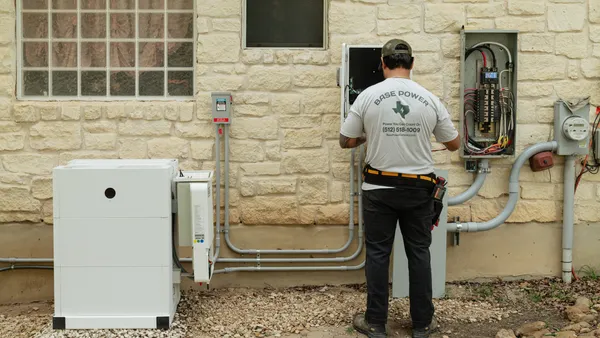As the efficiency saying goes, the cheapest megawatt is the one we don't use. In demand response parlance, the most expensive megawatt is the last one we need.
Thanks in large part to Mother Nature and those pesky things called “seasons,” the United States' electric grid is built for capacity we almost never use. A new report from Advanced Energy Economy (AEE) finds that 10% of the country's electric system is built to meet demand in just 1% of a year's hours. And reducing those demand peaks – typically met with the costliest, dirtiest electricity generation – can have a significant impact on consumers' bottom lines.
The group tapped Navigant to examine demand response in Illinois and Massachusetts, in an attempt to put a value on peak load management efforts, quantify the potential impact to consumers and determine how the resource can meet carbon goals. Ultimately, the group concluded that demand response is a proven resource that needs more attention from state regulators.
Mandates and market reforms can all be used to expand demand response's reach, and the resource may prove essential to meeting greenhouse gas restrictions. Utilities operating in organized markets will find demand response easier to grow and utilize, but states can also put in place policies and goals that will help grow the market for load management tools. And residential demand response, which has so far lagged the commercial and industrial segments, is poised for expansion if regulators put in place the right policies to help it grow.
“By passing peak demand reduction mandates into law, or creating peak demand reduction programs, policymakers and utilities in Massachusetts, Illinois, and neighboring states could significantly reduce costs for ratepayers, strengthen reliability, and facilitate compliance with the Clean Power Plan,” the report concluded.
J.R. Tolbert, AEE's senior director of state policy, said demand response “can and should be a go-to option for legislators and regulators.”
“The best structure for realizing the full potential for demand response is for states to adopt demand response standards and for these programs to be paired with participation in wholesale markets,” he said.
By the numbers: What's a DR dollar worth?
Simply by the numbers, Navigant's analysis in Illinois and Massachusetts shows just how significant demand response savings can be. At a minimum, every dollar spent on reducing peak demand will save consumers between $2 and $3. But a closer look at the findings reveals why demand response may be worth more in some states than in others, and how the value can increase over time for successful programs.
In the “low” scenario, where peak demand remains unchanged over a 10-year period, a demand-response dollar spent in Massachusetts returns $3.26 back to consumers. But in Illinois it's just $2.62, and the difference is exacerbated in the “medium” and “high” scenarios. If actual peak demand declines 0.5% annually for a decade, that Massachusetts DR dollar returns more than $4, while Illinois' return stays relatively stable.
Somewhat paradoxically, the value of effective demand response rises as the peaks decline. With a grid as overbuilt as the one in this country, decreasing the peaks can actually add value to demand response. But that ratio doesn't continue indefinitely in a practical way, Navigant noted in its analysis.
While the benefit-cost ratio “tends to increase as peak load is reduced, technical limits to the amount the peak load can be reduced with DR and energy efficiency resources limit how much of this benefit can be realized,” the report notes.
This is partly to do with capacity charges, the main area where demand response can have a market impact and transmission charges. Massachusetts is a net importer of electricity, and so Navigant assumed that peak demand reduction programs would reduce investment in both transmission and distribution. And because Illinois is a net exporter of electricity, Navigant explained that it assumed peak demand reductions would reduce only distribution costs.
No need to wait on the courts: State policy changes can grow DR now
While AEE's report focuses on results in Illinois and Massachusetts, the clear implication is that demand response can be grown anywhere. And despite upheaval in the industry, AEE's Tolbert said waiting on the U.S. Supreme Court to rule on FERC Order 745 isn't necessary.
“Regardless of the outcome of ESPA v. FERC, states should act now to establish standards that require reductions in peak demand via demand response,” Tolbert said. “These standards will create additional certainty within the marketplace for demand response providers.”
Oral arguments were heard last month in the case, which is a battle to see who has jurisdiction over demand response in wholesale markets. Order 745 mandated that demand response be compensated at the same rates as traditional generation, but the D.C. Circuit Court vacated the order last year. Arguments focused on whether FERC reasonably concluded it has authority over demand response markets, and whether the circuit court erred in its decision to invalidate that authority.
According to Tolbert, a “favorable” ruling for Order 745 – one where the court upholds FERC's jurisdiction over demand response markets – “will only strengthen the programs of those states that are leading on demand response. And hopefully will lead to the creation of wholesale markets in other regions of the country.”
Organized markets help boost the profitability of demand response, as well as making the resource easier to expand. But Tolbert said the biggest issue to be examined is market certainty. States can provide that certainty by establishing policy outcomes that set “clear peak demand reduction goals for their utilities based on a rigorous assessment of statewide demand response potential.” Policies which align the financial interests of utilities with demand response programs also need to be put in place, he said.
“Utilities can help grow this resource by calling on policy makers in their states to establish a demand response market,” Tolbert said. “These markets can successfully flourish on their own, and will be even more successful when paired with the organized wholesale market.”
Policies needed to grow residential demand response
Largely due to economies of scale – commercial and industrial customers simply have more load to play with – residential load management programs have always lagged in terms of cost effectiveness. Less than 5% of U.S. households participate in a demand response program right now; but despite the potential savings, the report also identifies barriers: Some customers simply do not want to compromise on comfort or control, and electricity's portion of household expenses is falling in some areas.
AEE's report found several options exist to expand residential demand response, including "tweaks to existing program design, new technologies to expand the availability of dynamic pricing, and considering new program models like behavioral DR and 'bring your own device/thermostat.'"
The report specifically mentioned Opower's behavioral demand response product, which allows utilities to target peak load reductions without the need to install hardware. When paired with a time-variant rate, the company has returned peak savings up to 5% (and 3% without the variable rate).
Tolbert said residential programs can become more cost effective through a variety of policy measures, including time-variant rates that reward customers for investment in distributed resources and demand response. He also said better integration with energy efficiency could help give DR a residential boost, perhaps by combining a home energy report for efficiency with a behavioral demand response program.
"Another example could be smart thermostats that optimize AC usage to reduce overall energy consumption and can be enrolled in AC cycling programs to target peak reduction," Tolbert said.














